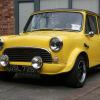Inlet Manifold Water Cooling
#1

Posted 02 December 2013 - 02:44 PM
pros and cons?
what's it do?!
how would I connect it? from the heater valve I think?
I've done loads of searching but none have really answered the questions :)
many thanks
sam
#2

Posted 02 December 2013 - 02:54 PM
http://www.theminifo...howtopic=143251
that should help, also i think it's water heating rather than cooling not sure of the pros or cons but might assist with combustion.
#3

Posted 02 December 2013 - 02:57 PM
http://www.theminifo...howtopic=143251
that should help, also i think it's water heating rather than cooling not sure of the pros or cons but might assist with combustion.
cheers dude..
#4

Posted 02 December 2013 - 03:03 PM
However, when running a cold inlet mixture will give more power as it has more ability for expansion when burned and thus should be more fuel efficient.
I never connect up the heated manifold pipes and, of course, the early Minis, including the Cooper and Cooper 'S' didn't have heated manifolds.
Personal choice really.
#5

Posted 02 December 2013 - 03:11 PM
also helps with carb freezing i believe......
#6

Posted 02 December 2013 - 03:13 PM
also helps with carb freezing i believe......
aha.. I lot of people arguing over this on other posts..
#7

Posted 02 December 2013 - 03:37 PM
In over 50 years of playing about with Minis I have never run water heated manifolds and have never had any carb icing issues. The early cars, when modified but retaining small carbs had this issue, but larger carbs don't tend to ice. An HS4 on a 998 or HS6/HIF44 is unlikely to ice up on a 1275. Twin SU's are not known to ice up at all - well maybe in minus 40 degree environments they might!
#8

Posted 02 December 2013 - 03:50 PM
also helps with carb freezing i believe......
Yes, useful as a chocolate fireguard
Heated manifolds are supposed to warm up fuel mixture to help atomization, this improves fuel consumption and emissions.
The downside is that this costs power, because the A series likes a rough fuel atomization, thats also why weber carbs give a better top end than the SUs.
#9

Posted 02 December 2013 - 03:51 PM
id love a chocolate fireguard.....
#10

Posted 02 December 2013 - 04:12 PM
also helps with carb freezing i believe......
Yes, useful as a chocolate fireguard
Heated manifolds are supposed to warm up fuel mixture to help atomization, this improves fuel consumption and emissions.
The downside is that this costs power, because the A series likes a rough fuel atomization, thats also why weber carbs give a better top end than the SUs.
Never seen any advantage at all. If a warm mixture is good, why do some turbo engines have intercoolers to cool the charge? The science has always been that the cooler the inlet mixture charge the more expansion capability it has when burned thus giving higher cylinder compressions and more power. I think I'll stick with that as it's always worked for me.
Others are welcome to do as they please, but don't rely on BLMC/Rover's dodgy engineering design to give a solution to a non-existent performance problem, except perhaps emission legislation. They are the company which gave us rubber mounted front sub-frames and mixed threads on braking systems ![]() .
.
#11

Posted 02 December 2013 - 04:17 PM
Exactly the point I made on the other thread. There were a long list of possible reasons, but when you look at them scientifically they make no sense. Cooperman - do you know when these heated/cooled manifolds first appeared?also helps with carb freezing i believe......
Yes, useful as a chocolate fireguard
Heated manifolds are supposed to warm up fuel mixture to help atomization, this improves fuel consumption and emissions.
The downside is that this costs power, because the A series likes a rough fuel atomization, thats also why weber carbs give a better top end than the SUs.
Never seen any advantage at all. If a warm mixture is good, why do some turbo engines have intercoolers to cool the charge? The science has always been that the cooler the inlet mixture charge the more expansion capability it has when burned thus giving higher cylinder compressions and more power. I think I'll stick with that as it's always worked for me.
Others are welcome to do as they please, but don't rely on BLMC/Rover's dodgy engineering design to give a solution to a non-existent performance problem, except perhaps emission legislation. They are the company which gave us rubber mounted front sub-frames and mixed threads on braking systems.
#12

Posted 02 December 2013 - 04:52 PM
I've never noticed any difference whether it be a loss of power or better running when cold. However, my Dad has one fitted to his 1098 Morris Minor van and he noticed it feeling a little less 'sharp' as the engine warmed up, he disconnected it and it's been fine since.
To be honest I think it's a bit of a gimmick. If you feel happier connecting it up then go ahead.
#13

Posted 02 December 2013 - 05:14 PM
I can't remember when those manifolds first appeared, about the time of the Metro I think, maybe 1980-ish.
To me they were never necessary any more then metric threads on an imperial thread braking system or rubber sub-frame mountings to make the car feel 'softer' for old lady drivers at the expense of the famous crisp steering feel of the Mini.
Rover screwed up the build quality and I have little time for their design abilities, or was there some other reason? Can't think what it might have been though. Oh, I know, pay your design engineers peanuts and you get monkeys sitting at your drawing boards ![]() .
.
Around that time I used to do business with Austin-Rover as they then were. I gave up in the end because they were completely hopeless to deal with. A 'logic free' environment.
#14

Posted 02 December 2013 - 07:17 PM
They appeared with the HIF44 on the A+ metro so early 80ies, also rover coopers had heated inlets. MG metro engine had also an heat exhanger above the oil filter, and that was interesting.
Peter, any tips and tricks for twin SUs from back in the days of rallying in the snow?
#15

Posted 02 December 2013 - 07:36 PM
It never seemed to be a problem and I rallied seriously in everything from standard 850 in 1961, through twin 1.25 SU's on 998 Cooper and 1275 'S's with twin H4's. Never had any carb icing. It is common on aircraft engines which have carb air heating, but that is needed for flight in high moisture (i.e. in or near clouds) at very low temperatures.
1 user(s) are reading this topic
0 members, 1 guests, 0 anonymous users


















